Related Research Articles
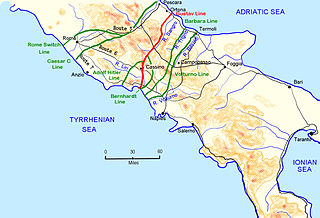
The Winter Line was a series of German and Italian military fortifications in Italy, constructed during World War II by Organisation Todt and commanded by Albert Kesselring. The series of three lines was designed to defend a western section of Italy, focused around the town of Monte Cassino, through which ran the important Highway 6 which led uninterrupted to Rome. The primary Gustav Line ran across Italy from just north of where the Garigliano River flows into the Tyrrhenian Sea in the west, through the Apennine Mountains to the mouth of the Sangro River on the Adriatic coast in the east. The two subsidiary lines, the Bernhardt Line and the Hitler Line, ran much shorter distances from the Tyrrehnian Sea to just northeast of Cassino where they would merge into the Gustav Line. Relative to the Gustav Line, the Hitler Line stood to the northwest and the Bernhardt Line to the southeast of the primary defenses.

Operation Jubilee or the Dieppe Raid was a disastrous Allied amphibious attack on the German-occupied port of Dieppe in northern France, during the Second World War. Over 6,050 infantry, predominantly Canadian, supported by a regiment of tanks, were put ashore from a naval force operating under the protection of Royal Air Force (RAF) fighters.

Events from the year 1943 in Canada.

The 1st Parachute Division was an elite German military parachute-landing division that fought during World War II. A division of paratroopers was termed a Fallschirmjäger Division. For reasons of secrecy, it was originally raised as the 7th Air Division, before being renamed and reorganized as the 1st Parachute Division in 1943.
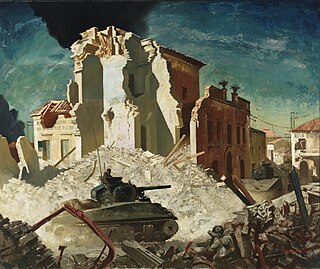
The Battle of Ortona was fought between two battalions of elite German Fallschirmjäger (paratroops) from the German 1st Parachute Division under Generalleutnant Richard Heidrich, and assaulting Canadian troops from the 1st Canadian Infantry Division under Major General Christopher Vokes. It was the culmination of the fighting on the Adriatic front in Italy during "Bloody December". The battle was known to those who fought it as the "Italian Stalingrad," and as "Little Stalingrad", for the brutality of its close-quarters combat, which was only worsened by the chaotic rubble of the town and the many booby traps used by both sides. The battle took place in the small Adriatic Sea town of Ortona (Abruzzo), with a peacetime population of 10,000.

Almost every country in the world participated in World War II. Most were neutral at the beginning, but only a relative few nations remained neutral to the end. The Second World War pitted two alliances against each other, the Axis powers and the Allied powers. It is estimated that 74 million people died, with estimates ranging from 40 million to 90 million dead. The main Axis powers were Nazi Germany, the Empire of Japan, and the Kingdom of Italy; while the United Kingdom, the United States, the Soviet Union and China were the "Big Four" Allied powers.

The 3rd Infantry Division was an infantry division of the German Army that fought in World War II. The division was established under the cover name Wehrgauleitung Frankfurt in 1934 by expanding the 3rd Division of the Reichswehr. It was redesignated Kommandant von Frankfurt shortly afterward, and took on its bona fide name when the formation of the Wehrmacht was announced in October 1935. In March 1939 the division took part in the invasion and occupation of Czechoslovakia.
The Canadian Provost Corps was the military police corps of the Canadian Army. The Canadian Provost Corps was authorized on 15 June 1940. The Canadian Provost Corps was amalgamated with the police forces of the Royal Canadian Navy and Royal Canadian Air Force to become a new, unified branch of the Canadian Forces in 1968, known as the Canadian Armed Forces Security and Intelligence Branch.

The history of Canada during World War II begins with the German invasion of Poland on 1 September 1939. While the Canadian Armed Forces were eventually active in nearly every theatre of war, most combat was centred in Italy, Northwestern Europe, and the North Atlantic. In all, some 1.1 million Canadians served in the Canadian Army, Royal Canadian Navy, Royal Canadian Air Force, out of a population that as of the 1941 Census had 11,506,655 people, and in forces across the empire, with approximately 42,000 killed and another 55,000 wounded. During the war, Canada was subject to direct attack in the Battle of the St. Lawrence, and in the shelling of a lighthouse at Estevan Point on Vancouver Island, British Columbia.
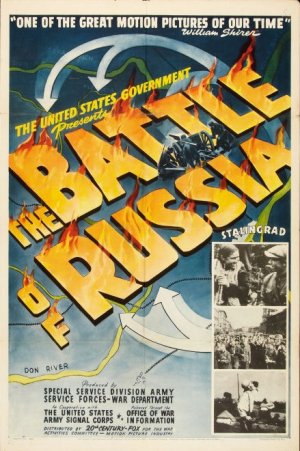
The Battle of Russia (1943) is the fifth film of Frank Capra's Why We Fight documentary series. The longest film of the series, it has two parts. It was made in collaboration with Russian-born Anatole Litvak as primary director under Capra's supervision. Litvak gave the film its "shape and orientation," and the film had seven writers with voice narration by Walter Huston. The score was done by the Russian-born Hollywood composer Dimitri Tiomkin and drew heavily on Tchaikovsky along with traditional Russian folk songs and ballads.

The Allied leaders of World War II listed below comprise the important political and military figures who fought for or supported the Allies during World War II. Engaged in total war, they had to adapt to new types of modern warfare, on the military, psychological and economic fronts.
The following outline is provided as an overview of and topical guide to World War II:
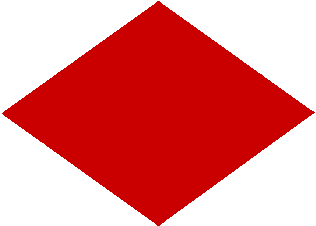
I Canadian Corps was one of the two corps fielded by the Canadian Army during the Second World War.

The 65th Infantry Division was a German division in World War II. It was formed in July 1942.

Break-through is an 11-minute 1944 Canadian documentary film, made by the National Film Board of Canada (NFB) as part of the wartime Canada Carries On series. The film documents the attack on Fortress Europe during the Second World War and the advance of Allied forces to the borders of Nazi Germany. Break-through was produced by James Beveridge. The film's French version title is L'assaut.

Bombing the Nazis is a 10-minute 1943 Canadian documentary film, made by the National Film Board of Canada (NFB) as part of the World War II newsreels shown at theatres in Canada and abroad. The film describes the Allied air war over Europe during the Second World War, concentrating on attacks in 1942 and 1943 on an automobile factory in Vichy France.
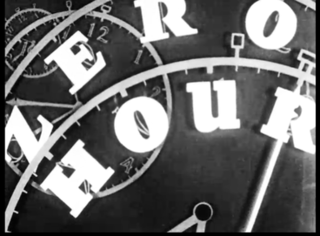
Zero Hour is a 22-minute 1944 Canadian documentary film, made by the National Film Board of Canada (NFB) as part of both the wartime Canada Carries On and The World in Action series. The film was produced by Stuart Legg. Zero Hour describes the Axis and Allied invasions that have taken place during the Second World War.
References
- 1 2 "Grusome Finale for Composer's Downtempo Life". Ottawa Citizen. 9 June 1982. Retrieved 15 March 2015.
- ↑ Corcelli, John (June 2005). "Canada at War". Canadian Communications Foundation. Retrieved 7 May 2010.
- ↑ Evans 1991, p. 107.